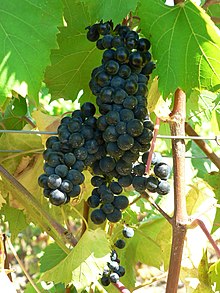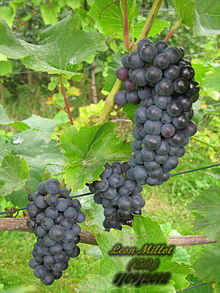Red

Rondo
A dark-skinned interspecific hybrid variety that performs very strongly in cold climates. The variety is a crossing of Saint-Laurent and Zarya Severa – an obscure Russian variety, prized for its frost-hardiness.
Rondo was first bred in the former Czechoslovakia in 1964, before it was further developed and cultivated at the Geisenheim Grape Breeding Institute in Germany.
As well as its ability to reliably ripen, Rondo is also well regarded because it is highly resistant to mildew diseases. It consistently produces high-quality, varietal red wine with deep color and good aroma, which a majority of other varieties struggle to do in cold-climates. Rondo is also produced for the use of blending to contribute color and tannins.
Mainly grown in Germany (notably the Rheinhessen and Rheingau regions), the variety is also grown in Poland, England, the Netherlands, Denmark, Wales and Sweden.

Regent
A dark-skinned hybrid variety developed in Germany that counts Chambourcin, Silvaner and Muller-Thurgau in its lineage.
The variety was created in 1967 in Pfalz, with the intention of finding a high-quality grape that could survive in cold climates. Regent produces good yields and is highly resistant to mildew diseases, the variety also has thick skins and an abundance of tannins.
Unusually, Regent’s flesh is stained red – a condition known as teinturier, and another indication that it is genetically geared toward producing powerful reds. It has been named for the Regent Diamond, part of the French Royal Treasury.
Although Regent is not immediately identifiable to most consumers, numerous growers are well aware of its many positive attributes. Plantings in Germany increased from 865 acres (350ha) in 2000 to 4,450 acres (1,800ha) in 2018. It has since been cultivated in Poland, Switzerland, England, the Netherlands, and in some cooler parts of the United States such as Washington’s Puget Sound region.
Regent wines are slowly starting to appear in the market in varietal form, emerging from its supporting role for other, better-known varieties. The variety is heralded as being one of the best hybrids for vinification, giving wines that are full bodied and densely colored with soft tannins and an abundance of red fruit flavours.

Zweigelt
A new Austrian grape created in 1922 by Friedrich Zweigelt (1888–1964), who later became Director of the Federal Institute and Experimental Station of Viticulture, Fruit Production and Horticulture (1938–1945). It comprises a crossing between St. Laurent and Blaufränkisch.
Widely planted in Austria, Zweigelt vines have made inroads in the Canadian wine regions of Ontario’s Niagara Peninsula and of British Columbia, with limited plantings in Hungary. In the Czech Republic it is known as Zweigeltrebe and is the third-most widely planted red-grape variety, comprising approximately 4.7% of total vineyards. It grows in most of the wine regions in Slovakia. As of 2010, newly established Belgian and Polish vineyards have also started to plant Zweigelt.

Pinot Noir
A red wine grape variety of the species Vitis vinifera. The name may also refer to wines created predominantly from Pinot noir grapes. The name is derived from the French words for pine and black. The word pine alludes to the grape variety having tightly clustered, pine cone-shaped bunches of fruit.
Pinot noir grapes are grown around the world, mostly in the cooler climates, and the grape is chiefly associated with the Burgundy region of France. Pinot noir is now used to make red wines around the world, as well as Champagne, sparkling white wines such as the Italian Franciacorta, and English sparkling wines. Regions that have gained a reputation for red Pinot noir wines include the Willamette Valley of Oregon; the Carneros, Central Coast, Sonoma Coast, and Russian River AVAs of California; the Elgin and Walker Bay wine regions of South Africa etc.
Pinot noir is a difficult variety to cultivate and transform into wine. The grape’s tendency to produce tightly packed clusters makes it susceptible to several viticultural hazards involving rot that require diligent canopy management. The thin skins and low levels of phenolic compounds lends pinot to producing mostly lightly colored, medium-bodied and low-tannin wines that can often go through phases of uneven and unpredictable aging. When young, wines made from Pinot noir tend to have red fruit aromas of cherries, raspberries, and strawberries. As the wine ages pinot has the potential to develop more vegetal and “barnyard” aromas that can contribute to the complexity of the wine
WHITE

Solaris
A hybrid white wine variety grown mainly in Baden, Germany, where it was developed in 1975. Its parent varieties are Merzling and the functionally named Gm 6493 – a crossing of Zarya Severa and Muscat Ottonel.
Solaris wines are most often made in off-dry styles, but the variety’s extremely high natural sugar levels make it well suited to the production of sweet wines. Varietal Solaris has characters of banana and hazelnut and is highly perfumed.
It is disease resistant, and ripens earlier than almost any other wine grape. The name Solaris, which means “sun”, is particularly apt, as the variety is used in regions noted for their cool climates and low sunshine levels. Solaris grapes produce high must weights and early-ripening fruit, an excellent combination for growers looking to ensure an abundant harvest.
In Europe’s very coldest wine regions – those in Poland, Denmark, Norway and Sweden – Solaris has proved invaluable as a wine grape. The variety is also found in various parts of northern Switzerland, Belgium and England.
In Germany Solaris is used almost exclusively as a blending agent, and is most often paired with Riesling or Pinot Blanc.

Riesling
Riesling, in terms of the size of the crop, is second to such varieties as Sauvignon Blanc and Chardonnay. It is considered the freshest grape variety by many experts, not only because of its noble taste, but also it is easy to grow. From this group of grapes are produced both dry, semi-sweet, sweet and sparkling wines. The popular known Rieslings, of course, come from Germany, where vines are often grown (they cover as many as 22.5 thousand ha. Large areas of Riesling are also found in the French Alsace, Austria, the Czech Republic, Italy (South Adige) and Italy. it is grown in Poland, Australia, New Zealand, South Africa, the USA and even in China, Bulgaria and Ukraine.

Hibernal
A variety of white wine grape of the hybrid with Vitis vinifera which was developed in 1944, by Heinrich Birk at the Geisenheim Grape Breeding Institute. The variety is a genetic crossbreed of the Seibel 7053 and Riesling clone 239 grape varieties.[1] Hibernal has had plant variety protection since 1977 and was included on the list of varieties in 1999.
Hibernal was developed for the same reasons as other new varieties developed by the Geisenheim Institute, such as Ehrenbreitsteiner, Dakapo, Rondo and Saphira. The basic idea was to develop pest and fungus-resistant vines. In bad years Hibernal is susceptible to mildew (powdery mildew and downy mildew) and must be provided with 1-2 sulphur treatments shortly before and/or shortly after flowering. The variety, however, has a very good winter hardiness even against stronger frosts.
The full-bodied and racy wine produced has a taste at times similar to a Scheurebe. The variety is particularly important in South East Europe.

Muscat Odessa
A very old grape variety, the origin of which ampelographers derive from Syria, Egypt or Arabia. It belongs to one of the three varieties (apart from Harslevel and Furmint) traditionally grown in the Tokaj region. It is also grown in Poland, France, Italy, Spain, Hungary, Yugoslavia, Bulgaria, Romania and the USA.

The presence of a light nutmeg variety ripening in late August under the name “Muscat Blanc” has been found in the country. This variety was brought by Roman Myśliwiec to Jasło in 1985 and most likely was given the name “Muscat Blanc” by him. It is almost certain that this variety is not the classic White Muscat grown in many countries for wine production. This issue is due to the fact that Muscat Blanc is a later variety and is characterized by very small grapes.

Johanniter
A purpose-bred, fungus-resistant white grape that is grown in small pockets of Germany and Switzerland, and it is also used in Poland’s wine industry. The variety was bred in 1968 by crossing Riesling with an unnamed grape of the lineage Seyve Villard 12-481 x (Rulander x Gutedel).
Wines made from Johanniter are somewhat similar to Riesling, with slightly less acidity and the potential to achieve good must weights. In 2002 an intense, concentrated Trockenbeerenauslese was reportedly made from Johanniter. This, however, would be unusual; most Johanniter wines are light and fruity, showing melon, pear and peach flavors.
Johanniter is named after Dr. Johannes Zimmermann, the former director of the vine breeding of the Freiburg Institute of Viticulture, where the grape was developed.
ROSE
Most Polish rosés are made with Rondo, Regent, Maréchal Foch, Zweigelt, Leon Millot – red grape varieties that do well in Polish climatic conditions. There is however one exception, a Merlot rosé made by one of the best Polish winemakers Agnieszka Wyrobek-Rousseau from Winnica Wieliczka.

Maréchal Foch
An inter-specific hybrid French red winegrape variety. It was developed at the Oberlin Institute in Colmar-Alsace, at the beginning of the 20th century, by Eugène Kuhlmann, then known as Kuhlmann 188-2. The variety arrived in the U.S. in 1946, where it was subsequently renamed Marechal Foch in honor of Marshall Ferdinand Foch, Supreme Allied Commander during the First World War. Some believe it to be a cross of Goldriesling (itself an intra-specific cross of Riesling and Courtiller Musqué) with a Vitis riparia – Vitis rupestris cross. Others contend that its pedigree is uncertain and may contain the grape variety Oberlin 595. It ripens early, and it is cold-hardy and resistant to fungal diseases. The berry size is small, which makes it prone to bird injury. The quality of wine produced by Marechal Foch vines is highly dependent upon vine age, and the flavour profile associated with many new-world hybrid varietals is much reduced in examples made with fruit picked from older vines.

Léon Millot
(sometimes called “Leon Millot Rouge” (or “Foster’s Leon”) to distinguish it from “Leon Millot Noir” (a.k.a. “Wagner’s Leon”) which many breeders believe to be Oberlin 595)
A red variety of hybrid grape, it was created in 1911 in the Oberlin Institute in Colmar, Alsace, by the French viticulturist Eugène Kuhlmann (1858–1932) by crossing the hybrid grape Millardet et Grasset 101-14 O.P. (which is Vitis riparia × Vitis rupestris) with Goldriesling, which is Vitis vinifera. The variety was named after the winemaker and tree nursery owner Léon Millot.
Léon Millot ripens early, is blue-skinned, grows with fair vigour, and has high resistance against fungal diseases, so it is therefore suited for cultivation in cooler climates. The grape has small berries and small clusters (perhaps 0.20 lbs/cluster), and thus it is time-consuming to manually harvest. It can yield a bigger wine similar to a ripe Syrah, or a lighter wine more in the style of Pinot Noir. Common aromatic and flavor profiles for Leon Millot include earthy/barnyard/woodsy notes, purple fruits, and chocolate.
***
The Polish Pink Wine Revolution
by Elizabeth Gabay MW (2018)

During my last trip to Poland in November 2017, I attended the Kraków wine fair, Enoexpo, to talk about the winning rosés from the first International Rosé Championship, which had been held in May, also in Kraków. During the fair, Michał Bardel, the editor of Czas Wina magazine, organised a tasting of Polish rosés for me and introduced me to Monika Bielka-Vescovi (founder of the Polish Wine School – Szkoła Sommelierów, president of the Polish Women and Wine Association, international wine judge and wine journalist. She teaches about wine at the Jagiellonian University in Kraków, Collegium Civitas in Warsaw and the Sub-Carpathian Wine Academy in Jasło).
Read more
